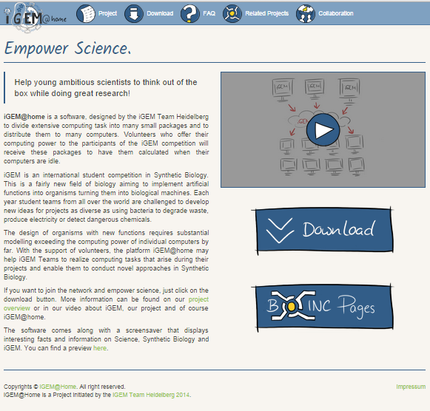Team:Heidelberg/pages/Human Practice/igemathome
From 2014.igem.org
Contents |
Introduction
iGEM@home is a platform (build upon the BOINC framework) for the distribution of computations to volunteers who provide their computer resources when it is idle. The volunteers download a client software that pulls work from our central server and runs it when the computer is not used. After the successful execution of the computation the result is uploaded to our server. This approach allows it iGEM teams to run heavy computations without the need of access to a big server cluster. Furthermore the inclusion of general citizens in the project as providers for calculation power enables us to spread the word about Synthetic Biology circumventing the classical gatekeepers. During the development of the project we wanted to reach people who usually have nothing to do with science, let alone Synthetic Biology and iGEM. Our project offers a unique chance to not just tell people about Synthetic Biology, but to offer them the chance to participate and really get involved in a project. This will hopefully lead to new kinds of collaboration, better understanding and a broader acceptance of Synthetic Biology.
If you want to know more about the software that we developed please visit our Software Overview page, if you are rather interested in the modelling that we ran on iGEM@home and how it relates to our project please visit the Linker modeling.
Outreach
The need to build a vivid community is key to run a successful distributed computing project. As the project depends on the voluntary support of people it is important to get people enthused about the science behind the project, so they are willing to support the project. Good communication is therefore essential to find support. We therefore used different channels to present and promote our project and iGEM in general to convince people to help us.
Promotion Material
Website
A central part of was our campaign for iGEM@home is the website www.igemathome.org that is the frontend of our BOINC server and therefore needed to be externally hosted. (To find out more about the software click here). It bundles all important information on the project and explains iGEM in a layman’s way to an idea in what context this project was developed. It also provides a list of FAQ’s that address most important concerns and questions that people have. In addition we also provide a list of other BOINC projects, because the client makes it very easy to support additional projects from different areas of science. Furthermore the website also hosts the “BOINC pages”. These are the pages, where participants can view the server status, manage their account, create a profile and join the discussion in the forums. (For more information on the role of the forum in the outreach you can skip to #Forums.)
Video
The second pillar of our promotion is a video that provides the information in an easily digestible way.
The video presents iGEM, our project and distributed computing. It explains why we need the support of the users and how to help us.
Flyer
To promote iGEM@home on local level to friends, fellow students and people interested in science and iGEM we created Flyers that are supposed to make people interested in the project and lead them (via QR-code or link) to our website.




Campaign
Although iGEM@home is open for everyone to participate, we decided to promote the project mainly to people we knew (friends, family, fellow students etc.) and people that are already active in the BOINC community. We used social media and forums to present the project and shared our video as it is the easiest way to get informed. Moreover our project was covered by 2 journals (Spektrum der Wissenschaft german popular science magazine and BioTechniques an international journal on Life Science Methods) who wrote articles about the project, which was very helpful to reach new user groups.
Contact to User base
The important job after convincing the user to try our software, is to convince them to continuously support us by constantly feeding them with interesting facts on iGEM and offering them ways to influence the project. The first pillar for the communication is an integrated forum software, where the user can help each other and directly contact as us the developers if they experience bugs. The second pillar is a screensaver, where we can show the users interesting facts on science and promote the projects [Link collaboration with Marburg] of fellow iGEM teams. This bidirectional communication enabled an optimal exchange between our users and us as the project developers.
 "
"
